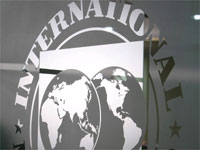G20 London 2009
The institutions: IMF and World Bank
by Salil Sarkar
Article published on the 2009-03-31 Latest update 2009-04-08 13:07 TU
The IMF has 185 member countries currently. But control over those bodies, chiefly the IMF, is exercised by the US and its allies. For instance, China now has the world's second-largest economy and 1.3 billion people, but has only 3.7% of the IMF's voting shares.
There has been a decade-long struggle to reform voting shares, and China finally got one of the largest increases in voting shares among developing countries in last year's fund "reforms".
Europe, Japan and the other rich countries could outvote the US, but prefer not to rock the boat. They fear that altering US dominance over the IMF and the World Bank might result in developing countries' gaining an audible voice.
Rich countries are backing a greater role for the two bodies, and more funds in resolving the crisis worldwide. But both have a poor record in matters of development. About 10 years ago, last major international economic crisis began in Asia.
At the time the US led a large funding increase for the IMF. The fund’s prescriptions actually worsened the crisis in Asia, typically by attaching harmful economic and structural conditions to its lending in the countries hardest hit by the crisis, mainly: Indonesia, Thailand, South Korea and the Philippines.
In Russia, under the corrupt Yeltsin years, and in Argentina, the IMF’s actions aggravated the problems there. Latin America suffered its worst long-term growth failure in modern history under the IMF's tutelage since 1980.
The Asian financial crisis in the late 1990s was a tipping point. The IMF and the US Treasury helped create the crisis by pushing for the removal of important regulations on foreign capital flows. They made it worse with their policy recommendations, prompting economist Jeffrey Sachs - now head of Columbia University's Earth Institute, to say that "the IMF has become the Typhoid Mary of emerging markets, spreading recessions in country after country."
Countries, especially in Asia, have since decided to reduce their ties to a minimum with the Washington consensus bodies. They have piled up their own cash reserves so as to never need to go back to the IMF again.
Have things changed since? Not really. The fund is still applying its crippling criteria, insisting that poor countries slash educational, social, health and related spending to reduce deficits. By failing that, the IMF would lend no money.
This is visible in nine agreements the IMF has negotiated since September 2008, with several eastern European countries, El Salvador and Pakistan. The fund demands fiscal or budget tightening, interest rate increases, wage freezes for public employees and other measures that will reduce demand or prevent economic stimulus programs in those countries.
Many NGOs argue that free trade agreements "may undermine the recommendations to be proposed by the UN Commission".
For rich countries, on the other hand, the IMF is currently recommending a global fiscal stimulus of two per cent of GDP. But not for the developing countries, their argument goes, they cannot afford expensive stimulus policies during a recession.
The main reason they "cannot afford" to do what rich countries are doing, mainly run large budget deficits, is that they may run out of foreign exchange reserves (mostly dollars).
In other words, if they grow at a normal pace while other economies shrink, their imports will grow faster than their exports, and their trade balance will worsen. Rationally that is exactly what external support should allow, not shrink the economy to improve the trade balance.
The IMF’s loss of credibility and influence is probably the most important change in the international financial system in more than half a century. Until just a few years ago, the IMF was one of the most powerful financial institutions in the world and the major avenue of influence for the US in developing countries.
This was not so much a direct result of the money that it lent - the World Bank loans much more, but because of its position at the top of a hierarchy of official creditors.
Until a few years ago, a developing-country government that did not meet IMF conditions ran the risk of being economically strangled.
The World Bank, regional banks such as the Inter-American Development Bank, rich governments and sometimes even the private sector would withhold lending until the government reached agreement with the IMF.
At the top of this powerful creditors cartel sits the US Treasury Department, which holds a formal veto over many of the IMF's decisions and is an informal power within the organisation that marginalises even the other rich countries.
Developing countries - the ones that have historically borne the brunt of IMF decisions, have little or no effective voice in the decision-making of the organisation, where the majority of votes of the 185 member nations are assigned to the rich members.
The collapse of the IMF creditors’ cartel has been a huge blow to US influence. In Latin America, a region that used to be referred to as the "backyard" of the US, states are more independent of Washington than Europe is.
The problem is that poorer countries, especially in Africa, remain dependent on foreign aid from the IMF, the World Bank and other similar sources, to fund their basic budget and import needs. This can be harmful to their development and their people. These countries need to join the rest of the developing world in breaking free of the IMF's policy conditions.






